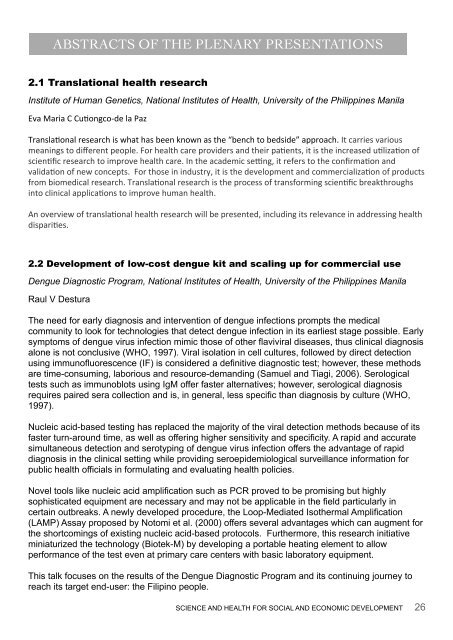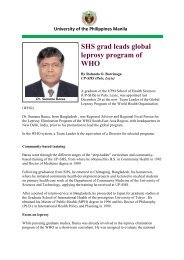NIH 2013 Program - University of the Philippines Manila
NIH 2013 Program - University of the Philippines Manila
NIH 2013 Program - University of the Philippines Manila
You also want an ePaper? Increase the reach of your titles
YUMPU automatically turns print PDFs into web optimized ePapers that Google loves.
ABSTRACTS OF THE PLENARY PRESENTATIONS<br />
2.1 Translational health research<br />
Institute <strong>of</strong> Human Genetics, National Institutes <strong>of</strong> Health, <strong>University</strong> <strong>of</strong> <strong>the</strong> <strong>Philippines</strong> <strong>Manila</strong><br />
Eva Maria C Cu$ongco-‐de la Paz<br />
Transla$onal research is what has been known as <strong>the</strong> “bench to bedside” approach. It carries various<br />
meanings to different people. For health care providers and <strong>the</strong>ir pa$ents, it is <strong>the</strong> increased u$liza$on <strong>of</strong><br />
scien$fic research to improve health care. In <strong>the</strong> academic sehng, it refers to <strong>the</strong> confirma$on and<br />
valida$on <strong>of</strong> new concepts. For those in industry, it is <strong>the</strong> development and commercializa$on <strong>of</strong> products<br />
from biomedical research. Transla$onal research is <strong>the</strong> process <strong>of</strong> transforming scien$fic breakthroughs<br />
into clinical applica$ons to improve human health.<br />
An overview <strong>of</strong> transla$onal health research will be presented, including its relevance in addressing health<br />
dispari$es.<br />
2.2 Development <strong>of</strong> low-cost dengue kit and scaling up for commercial use<br />
Dengue Diagnostic <strong>Program</strong>, National Institutes <strong>of</strong> Health, <strong>University</strong> <strong>of</strong> <strong>the</strong> <strong>Philippines</strong> <strong>Manila</strong><br />
Raul V Destura<br />
The need for early diagnosis and intervention <strong>of</strong> dengue infections prompts <strong>the</strong> medical<br />
community to look for technologies that detect dengue infection in its earliest stage possible. Early<br />
symptoms <strong>of</strong> dengue virus infection mimic those <strong>of</strong> o<strong>the</strong>r flaviviral diseases, thus clinical diagnosis<br />
alone is not conclusive (WHO, 1997). Viral isolation in cell cultures, followed by direct detection<br />
using immun<strong>of</strong>luorescence (IF) is considered a definitive diagnostic test; however, <strong>the</strong>se methods<br />
are time-consuming, laborious and resource-demanding (Samuel and Tiagi, 2006). Serological<br />
tests such as immunoblots using IgM <strong>of</strong>fer faster alternatives; however, serological diagnosis<br />
requires paired sera collection and is, in general, less specific than diagnosis by culture (WHO,<br />
1997).<br />
Nucleic acid-based testing has replaced <strong>the</strong> majority <strong>of</strong> <strong>the</strong> viral detection methods because <strong>of</strong> its<br />
faster turn-around time, as well as <strong>of</strong>fering higher sensitivity and specificity. A rapid and accurate<br />
simultaneous detection and serotyping <strong>of</strong> dengue virus infection <strong>of</strong>fers <strong>the</strong> advantage <strong>of</strong> rapid<br />
diagnosis in <strong>the</strong> clinical setting while providing seroepidemiological surveillance information for<br />
public health <strong>of</strong>ficials in formulating and evaluating health policies.<br />
Novel tools like nucleic acid amplification such as PCR proved to be promising but highly<br />
sophisticated equipment are necessary and may not be applicable in <strong>the</strong> field particularly in<br />
certain outbreaks. A newly developed procedure, <strong>the</strong> Loop-Mediated Iso<strong>the</strong>rmal Amplification<br />
(LAMP) Assay proposed by Notomi et al. (2000) <strong>of</strong>fers several advantages which can augment for<br />
<strong>the</strong> shortcomings <strong>of</strong> existing nucleic acid-based protocols. Fur<strong>the</strong>rmore, this research initiative<br />
miniaturized <strong>the</strong> technology (Biotek-M) by developing a portable heating element to allow<br />
performance <strong>of</strong> <strong>the</strong> test even at primary care centers with basic laboratory equipment.<br />
This talk focuses on <strong>the</strong> results <strong>of</strong> <strong>the</strong> Dengue Diagnostic <strong>Program</strong> and its continuing journey to<br />
reach its target end-user: <strong>the</strong> Filipino people.<br />
SCIENCE AND HEALTH FOR SOCIAL AND ECONOMIC DEVELOPMENT 26




